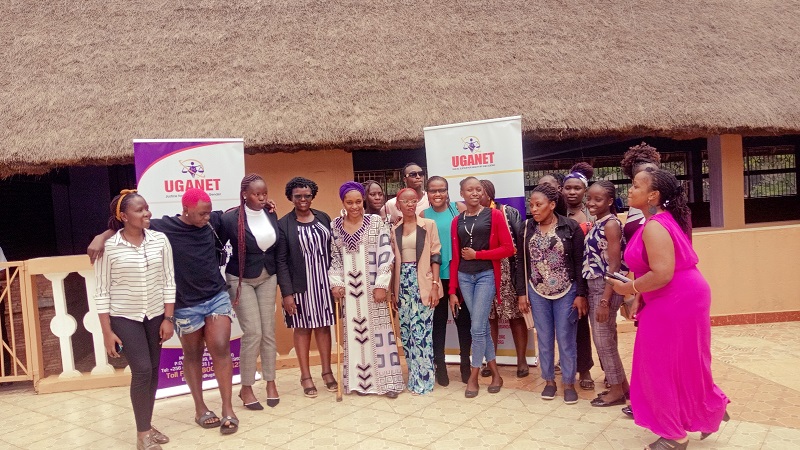
KAMPALA – Adolescent girls and young women in Uganda have revealed that protection of their basic human rights remains an unfulfilled promise largely due to discrimination.
These were on Thursday speaking to the press during a media cafe organized by Uganda Network On Law, Ethics and HIV/AIDS – UGANET in support of Hivos Global.
They noted that Sexual and Reproductive Health and Rights – SRHR should realize the right to dignity and personal liberty which centres around the autonomy of a person.
Presenting a position paper which was developed after the varying discussions held during a 2-day advocacy training with young women and adolescent girls held at Esella Country Hotel from 31st August to 1st September 2023 who brainstormed on gaps affecting access to SRHR and body autonomy in Uganda, Ms. Aisha, a young woman from Tunaweza foundation living with disability noted that ideally, every person should have the freedom to make independent decisions in their lives, free from coercion, intimidation and or fear. Equally freedom from non-discrimination and the right to equality are fundamental and critical to the realisation of SRHR.
“To a large extent, Chapter 4 of the 1995 Uganda Constitution espouses these core principles, freedoms, and rights, however, for many individuals, groups and communities in Uganda, protection of such basic human rights remains an unfulfilled promise.”
These decried negative biases attached to a person’s HIV status, criminalization of HIV, criminalization of consensual sex between people of the same sex, and criminalization of critical reproductive health needs for women stand as significant impediments to the realization of human rights, particularly SRHR amongst young people, younger women, sex workers and communities that are generally marginalized.
Ms. Aisha noted that under normal circumstances, SRH rights address the prevention of sexually transmitted diseases, including HIV, gender-based violence, maternal mortality and the provision of essential health services.
“Since the International Conference on Population and Development (1994) and the Beijing Platform for Action (1995), national SRHR policies have been demonstrated to support societies and contribute to a country’s wealth. The importance of SRHR is further underscored by section 5.6 of Sustainable Development Goal 5, dedicated to achieving SRHR for all.”
Uganda has a population of about 45.75 million people with a growth rate of 3.2% per year, 75% of this population is under the age of 30 according to United Nations Population Fund – UNFPA. The total fertility rate averages 5.4 children for every woman of childbearing age and the average age of sexual debut in Uganda is 16 (UDHS).
The maternal mortality rate is 336 for every 100,000 live births, 28% of which occur among girls between the ages of 15 to 24 years and unsafe abortion contributes 9% to the maternal mortality rate (UDHS) and the unmet family planning need is at 32% with rural areas suffering the highest disparities, adolescent pregnancy rate stands at 25% among girls aged 15 to 19 years with 12% of adolescent girls married off, which contributes to 23% of school dropouts.
Uganda Demographic and Health Survey indicates that HIV prevalence stands at 6.2% amongst the entire population with young women aged 15 to 24 years bearing the biggest burden since their infection rates are 4 times higher than the rest of the population.
Again, UNFPA says gender-based violence remains endemic with 56% of the female population reporting having experienced intimate partner violence and 22% reporting having experienced sexual violence of some sort.
Uganda Bureau of Statistics – UBOS indicates that the biggest drivers for Uganda’s SRHR indicators include poverty with reports showing that 65% of youth between 20 to 24 are unemployed and 21.4% of Ugandans living below the poverty line which adolescent girls and young women – AGYW say limits their economic access to SRH services especially, sexual minorities, women and girls who have even greater barriers to economic resources which affects their autonomy and agency.
They attributed the challenges to the health care system like; lack of skilled staff, limited access to health services, commodity stock outs, poor adolescent responsive health systems and weak implementation of laws, policies and strategies which also escalate these SRHR indicators.
“More so, there are deeply entrenched socio-cultural and religious beliefs that shape policies, social norms and practices and ultimately negatively influence SRHR separating it into visible issues which majority of people are willing to address as opposed to invisible issues which face great backlash, are heavily stigmatized and receive little to no government interventions. Worth noting is that the invisible SRHR issues are also usually affected by laws and policies where they are either criminalized or ignored.”
These seek;
- Inclusivity of People with disabilities in programming and uptake of SRHR services.
- Dispensing of sanitary towels in health facilities and workplaces.
- Deterring of negative attitude from health workers who create bias to recipients of SRHR services.
- Provision of affordable SRHR services.
- Sensitization of parents in educating children on SRHR and body autonomy.
- Provision of sign language interpreters at health facilities.
- Need for mental health safe spaces for young women and adolescent girls to express their grievances.
- Need for comprehensive antenatal packages at ART health facilities.





